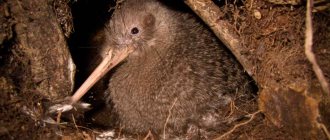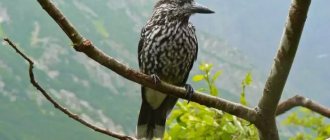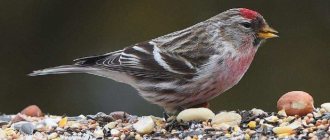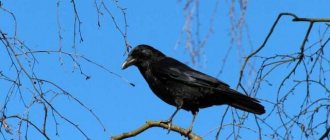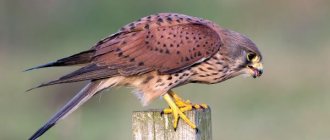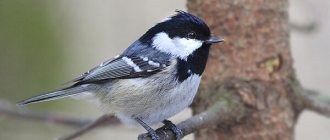The jay is a bird of the corvid family with bright plumage. It is found in Europe, North Africa, Asia, and the Caucasus. In northern latitudes, the jay is a migratory bird; in warm places it is a sedentary bird. Prefers to settle in forests and woodlands.
In the article we will look at what types of jays there are, the features of their lifestyle, reproduction and nesting.
This is what a common jay looks like
Features and lifestyle
Jays attract the eye with their beautiful bright plumage. These birds can imitate different sounds very skillfully. The jay's body length is about 45 cm, weight - no more than 200 g. The beak is short and sharp, the legs are long, the fingers have tenacious claws. The plumage deserves special attention:
- there is a small motley crest on the head, and a gray-white ornament on the forehead;
- the neck, back of the head, and abdomen are beige-pink in color with a transition of shades;
- in the central part under the beak the throat is white;
- there are black stripes on the sides of the beak;
- the middle of the wings is covered with blue-blue stripes, and their edges have a black tint.
The plumage color of chicks is not as bright as that of adult birds. Males differ from females only in their larger sizes. In flight, the jay looks especially beautiful, putting all its plumage on display for everyone to see. Descending to the ground, she moves by jumping.
INTERESTING FACT. The color of the iris of jays varies depending on age. In chicks it is dark brown, in adults it is light blue.
The jay is diurnal, but it is difficult to see them in nature. Wild birds are quite shy and always try to hide when they hear any sounds or rustles. They often emit sharp screams, notifying their relatives of approaching danger. The exception is birds living within the city. They get used to people and make it possible to get closer to a distance of 4-5 meters.
Jays do not have beautiful voices. They mainly make whistles, clicks, and crackles, but they easily repeat the sounds of other birds or animals. If they live in a village, they can easily imitate the meow of a cat, the voice of a goat or sheep, the creaking of a door, or the sound of an ax. Birds kept in captivity are able to repeat words after humans. Interestingly, they imitate not only sounds, but also intonation.
Watch a jay imitate a cat's meow:
Jays love to live in the crowns of trees; they rarely descend to the ground or fly in open areas. They usually live in pairs, but with the onset of cold weather they gather in groups of up to 30 people. This is how they escape the cold.
Two jays approaching each other
Natural enemies
Jays are hunted by feathered predators and some animals. Humans have a negative impact on the habitat of birds. After visiting a field sprayed with pesticides or other toxic substances, birds often die from poisoning. In order to preserve the harvest of grapes, apples, pears and other fruits, people set various traps for birds, which catch jays.
Notes
- ↑ 12
[www.publishersweekly.com/pw/by-topic/childrens/childrens-book-news/article/44359-mockingjay-sells-more-than-450-000-copies-in-first-week.html 'Mockingjay' Sells More Than 450,000 Copies in First Week] (English) // [www.publishersweekly.com/ Publishers Weekly]. — 2010-09-02. - Sellers J.
[www.publishersweekly.com/pw/by-topic/new-titles/adult-announcements/article/8359-hungry-the-latest-on-e2-80-98the-hunger-games-e2-80- 99-.html Hungry? The Latest on 'The Hunger Games'] (English) // [www.publishersweekly.com/ Publishers Weekly]. — 2009-03-12. - Staskiewicz K.
[shelf-life.ew.com/2010/02/11/final-hunger-games-novel-has-been-given-a-title-and-a-cover/ Final 'Hunger Games' novel has been given a title and a cover] (English) // Entertainment Weekly. — 2010-02-11. - ↑ 1 2 Roback D.
[www.publishersweekly.com/pw/by-topic/childrens/childrens-book-news/article/42030-mockingjay-to-conclude-the-hunger-games-trilogy.html 'Mockingjay' to Conclude the Hunger Games Trilogy] (English) // [www.publishersweekly.com/ Publishers Weekly]. — 2010-02-11. - [mediaroom.scholastic.com/node/349 Scholastic Increases First Printing of Mockingjay, the Final Book of The Hunger Games Trilogy, to 1.2 Million Copies] (English) // [www.scholastic.com/ Scholastic]. — 2010-07-01.
- [mediaroom.scholastic.com/node/349 Hungry for Mockingjay giveaways?] (English) // [www.scholastic.com/ Scholastic]. — 2010-07-30.
- Wilkinson A.
[hollywoodcrush.mtv.com/2010/08/24/mockingjay-hunger-games-midnight-release-party/ 'Mockingjay' Official Midnight Release Party: We Were There!] (English) // [www. scholastic.com/scholastic]. — 2010-08-24. - Collins S.
[www.ozon.ru/context/detail/id/7405395/ Mockingjay]. - St. Petersburg: Astrel, 2011. - 416 p. — 15,000 copies. — ISBN 9785271371097. - Collins S.
[www.ozon.ru/context/detail/id/7405416/ Mockingjay]. - St. Petersburg: Astrel, 2011. - 416 p. — 5000 copies. — ISBN 9785271371103.
What do they eat?
The basis of the diet is food of plant origin, for example, nuts, acorns, raspberries, rowan berries, etc. Jays often rule the fields where they find wheat, rye, barley, sunflower, and oats. At the end of spring and before the onset of cold weather, they eat animal food: chafers, bronze beetles, and silkworm caterpillars. Insects are definitely included in the menu of chicks. If there is a lack of food, the jay may develop predatory instincts - it can kill a mouse, lizard, frog or small bird.
With the onset of cold weather, jays stock up. They carry food in their beaks and hide it under the bark of a tree, in dry grass or leaves. Winter reserves by weight can be 3-4 kg. Birds often forget about winter reserves, and with the onset of spring the seeds germinate. Thus, they facilitate the spread of plants and trees over long distances.
In winter, in search of food supply, jays move closer to human habitation. Then they can often be seen in villages, suburbs and city parks.
Nutrition
These birds enjoy eating plant foods: seeds, nuts and berries. Subspecies found in Europe eat acorns. Moreover, they store these products in significant quantities for the winter, which contributes to the spread of oak trees.
One jay can hide up to 4 kg of acorns, dragging its trophies over a considerable distance, and then forget about its pantry. In this way, entire oak groves grow successfully.
By similar actions they spread other tree seeds, for example, rowan and bird cherry.
These winged creatures do not disdain animal food, although they only consume small-sized creatures as food, for example, small amphibians and tiny reptiles, caterpillars, worms, and frogs.
They eat mice, other rodents, insects - spiders and others. With their gluttony, jays also harm their own relatives, the sparrows, eating their eggs and young with great pleasure, and without pity destroying the nests of these winged brothers.
But jays themselves often become victims of other people’s cruelty. And their first enemy is man. And the attractiveness of the birds’ outfit is very beneficial to hunters; you just need to remember what a jay looks like .
After all, it is incredibly easy and convenient to take aim at such “shining” creatures. Of the feathered predators, their enemies are the goshawk, eagle owl, and crow. From the animal kingdom, the cunning marten poses a danger to jays.
By feeding their chicks with caterpillars and harmful insects, especially eating the pine longhorned beetle, which other birds prefer not to touch, jays turn out to be very useful, for which they are rightfully awarded by naturalists the title of forest orderlies.
Types of jays
There are more than 40 species of these birds in the world. However, ornithologists say that there may be unstudied species living in places inaccessible to humans. The most common types are the following:
- The common jay lives in the forests of Europe, Asia and northern Africa. Among other species, it is considered the largest.
- Decorated jay - distinguished by a dark purple coloring of the head and wings, a brown tone of the back and abdomen. They are distributed only in Japan.
- Himalayan jay - lives in the Himalayas. The feather color is very diverse: the head is black and resembles a crow, the color of the body and wings is similar to the common jay, but the plumage on the back has a gray tint.
- Saxaul jay - lives in the bushes and steppes of Mongolia. In appearance it resembles a small crow. It is known that this bird prefers to run or jump, but it flies poorly.
- The crested jay has a long crest and gray-brown plumage. There is a black and white spot on the neck. Lives in Thailand and Malaysia. Unlike other species, it is not afraid of people. Young birds are distinguished by their striped, variegated color; as they grow older, the plumage changes to black.
- American blue jay - lives in mixed and pine forests of central America. The main color of its plumage is blue-blue, the belly and feathers around the eyes are white. The edges of the wings and tail are white.
- The black-headed jay is a bird that lives in Mexican forests. The structure of its tail is very similar to that of a magpie. The bird has a black crest that curls when excited. The plumage of the back, neck and tail is blue, the belly is white. The voice of these birds resembles the cry of parrots.
- Scrub Blue Jay - This species lives in the forested areas of Florida. The head, wings and back have blue plumage, the bottom is light gray. This species is rare and is listed in the Red Book.
- The Yucatan jay is a rare species; their representatives are very afraid of people, so it is difficult to see them. They live in the forests of North America in the ruins of old buildings. The head and body are covered with black plumage, the wings and tail are bright blue.
- The mockingjay is a species of bird created by crossing female mockingbirds and male chattering jays.
Unfortunately, the number of some species is significantly declining. This is due to thoughtless human activities, especially deforestation - the main habitat of these beautiful birds.
Red-listed blue jay in the wild
Natural enemies
The jay is in itself a dangerous enemy for many small birds, especially during the nesting period. But at the same time, they rarely become objects of hunting for other predators, because they are very careful and timid.
But human activity poses a real threat to jays. Shooting, nest destruction, dangerous pesticides, crop protection traps - all this leads to a decline in the population.
Photo: placepic.ru
Nightingale (60 photos): description, habitat and what it eats
Reproduction and care of chicks
Jays reach sexual maturity in the first year of life. Birds begin to actively search for a partner in early spring and create pairs for life. Males try to attract females by flying over the treetops and putting on real concerts. Their song includes sounds made by other birds, as well as imitations of forest noise.
jay nest
The new pair begins building a nest in April. It can be used several times by the same parents. Construction takes at least a week. The nest, about 20 cm in diameter, is cup-shaped and 8-10 cm deep. It is based on tree branches, and the inside surface is covered with hay, moss and feathers. The clutch usually contains 5-7 eggs of a dark green hue. Sometimes it happens that the nest is destroyed by a marten or ferret. If this happens before summer, the female may lay eggs again. Both parents take turns doing incubation.
Description and feeding of chicks
The chicks hatch in 2.5-3 weeks. They are very voracious and can take food from each other. If there is a lack of insects, some of the babies die. If the food supply is sufficient, then after 3 weeks the chicks leave the nest. However, parents still feed and care for them until the beginning of autumn.
Links
Movies - The Hunger Games (soundtrack)
- The Hunger Games: Catching Fire (soundtrack)
- The Hunger Games: Mockingjay (Part 1, Part 2)
Music - "Safe & Sound"
- "Eyes Open"
- "Atlas"
- "We Remain"
- Elastic Heart
- "Everybody Wants to Rule the World"
- "Yellow Flicker Beat"
- "Meltdown"
- "All My Love"
- "The Hanging Tree"
Characters - Katniss Everdeen
- Peeta Mellark
- Gail Hawthorne
- Haymitch Abernathy
Interesting facts about jays
Jays sometimes display remarkable intelligence and ingenuity. Thanks to their sharp mind and ingenuity, they survive in difficult conditions. Here are some interesting facts about the jay:
- To make a pantry with supplies, these birds can ruin someone else's stock. Jays, spying on their relatives or other birds, steal food from them and hide them in their secret places. When there is a large concentration of jays, you can see a kind of competition taking place to find and carry someone else's food. They do not disdain the storehouses of squirrels, chipmunks and other animals. Jays steal acorns from woodpeckers. They are very careful, and before hiding their prey, they look around, fly from place to place, and, making sure that no one is watching them, hide the supplies.
- Jays have an interesting way of getting rid of parasites. They find an anthill and walk along it or sit on top. The ants spray the bird with acid, which kills the parasites that appear on the feathers.
- In the wild, jays live for about 7 years. In favorable climatic conditions and with a good food supply, some birds lived up to 16 years. It is known that a wild jay chick can be tamed. With proper care in captivity, birds can live up to 20 years.
Jay stores acorns for the winter
general description
Now it is difficult to say unambiguously where the name jay came from. Presumably, it arose due to the shining plumage. Jays are bred into a separate genus and belong to the corvids along with jackdaws, crows and rooks.
Appearance
The size of the jay resembles a jackdaw - up to 37 cm in length including the tail. The average weight is about 150 g, and the wingspan is 55 cm. There are larger and smaller individuals, and in addition, different species differ.
Jays have a reddish-brown body with a slight pink tint and bright blue feathers on the sides. They have a black tail and wing tips with white accents, and an equally dark beak.
The jay has a funny crest on its head, which becomes even more disheveled if the bird is excited. They have loose, fluffy plumage, which makes the body appear larger than it actually is. The large beak and thin, tenacious fingers with sharp claws stand out.
Photo: photonomy.ru
Juveniles: differences
Male and female jays are practically the same, except that males are slightly larger. But very young birds can be distinguished. They do not have such contrasting and bright plumage, and also have dark brown eyes, which become blue with age.
Photo: krasivosti.pro
Singing
Their “native” trills of jays are quite specific and resemble a set of sharp, grinding sounds. But the bird is an excellent learner and can copy almost anything, even human speech. For this they are called mockingbirds.
Photo: krasivosti.pro
How long do jays live?
In their natural environment, jays live 5-7 years, but this period can be extended even 2-3 times. Chicks raised in captivity from an early age live up to 20 years. It all depends on how comfortable the conditions are.
Photo: pinterest.ru
Keeping jays at home
Jays and other corvids are very intelligent and sociable, so they are often kept as pets. The omnivorous nature of these birds makes it easier for the owner to find food. It is enough to feed the bird with what is in the refrigerator. But to maintain good health, the jay needs a varied menu.
The difficulty of keeping them is flying feathers and droppings, so it is better to place the bird in a spacious enclosure rather than in a cage. It should be equipped with a large branch with many knots or several perches. Shoots of living trees are not suitable for this purpose; it is better to choose a dry tree that has fallen long ago. An excellent option would be strong oak branches. The floor of the enclosure must be covered with easy-to-clean material, such as linoleum. Sawdust is poured on top or paper is spread.
The desire to have a jay should be well thought out so that later it does not become a burden. You should not buy a bird for a child, as children's interests change quickly.
You need to buy a young bird - they quickly tame and get used to their owner. An adult wild bird cannot be domesticated. Even if you take home a tamed jay from another owner, the likelihood that it will get used to you is not great. In captivity, birds are kept alone, otherwise two or more individuals will fight among themselves and injure each other.
Habitat of the jay bird
Representatives of the passerine family spread widely across the European continent and in northern Africa, eastern Russia and a number of Asian countries. A bright bird with a loud voice can be found in Morocco, Algeria, the Kuril Islands, Sakhalin, in regions located beyond the Urals and the countries of North America.
Birds of all subspecies prefer to settle in forests where there is a lot of beech and oak trees with their favorite delicacy (acorns). Representatives are found in forested areas, city parks, and large orchards. In regions with warmer climates, birds can settle in areas with dense bushes.
What to feed
You can feed jays and other birds of the corvid family with boiled minced meat, small pieces of meat, cottage cheese, eggs, various cereals, grated vegetables, fruits, and nuts. It is imperative to add minerals; the bird needs them, especially during the molting process. It is advisable to give minerals in the form of a special “bird stone”, which is sold in almost any pet store. You can offer your pet whole raw eggs. The bird will drink the internal contents and eat the shell as mineral food.
There must be clean water in the cage or enclosure in the drinking bowl and separately in the bathing container. To take a bath, pour water into a wide tray with high sides or a basin.
Jay with food in an aviary
Walk
To keep the bird healthy, you need to let it fly. This can be done in an apartment, but it’s better to do it in the yard under the supervision of the owner. In this case, care should be taken, since a gullible bird may suffer at the hands of other people.
INTERESTING FACT. Jays are good at distinguishing familiar people from strangers. They distinguish the owner's voice well and fly to his call.
Toys and entertainment
Jays are fidgety creatures, so they need to be given some toys. Like most members of the corvid family, jays love shiny things. You can put foil, coins, a ball, a box of counting sticks, etc. in their cage. If you don't provide them with entertainment, they will find something to play with on their own, for example, they will pull wallpaper, tear leaves of indoor plants, and peck at watches and decorations.
To teach a jay to speak humanly, you need to communicate with it regularly. You can call her by name, pronounce simple phrases, and the result will not take long to arrive. But it is important to remember that only a tame jay can be taught to speak. Adult birds that are taken home rarely repeat words after humans.
Where to buy jay
It is better to buy jays at the Bird Market, but these birds are not always on sale. The common jay is not a rare species, so you can take a young individual from the nest. But this must be done with the utmost caution. You cannot take very small chicks - it will be very difficult to feed them. A grown-up baby who is about to leave the nest will approach. Also, you should not come close to the chicks when the parents are nearby. You should wait until they fly away and take one chick. You need to come to the nesting site with a helmet on your head to protect yourself from a possible attack by the chick’s parents. After removing a young jay, you should be sure to check whether the adult birds have returned to the rest of the chicks.
If you pick up a sick adult jay, you need to carefully examine it. If a bird cannot fly due to broken feathers, they should be broken off so that new ones can grow in this place faster. If there are complex injuries, you should take her to a veterinarian. If after recovery the bird can walk and fly, it is better to release it. There are cases when a wounded jay got used to its owner and did not want to fly away from him. Then she becomes a faithful friend for many years. If, after receiving injuries, the bird can no longer lead its usual way of life, it cannot be released. In this case, you can keep it or give it to good hands.
Excerpt characterizing Mockingjay
- Ah! “quel bonheur pour la princesse,” she spoke. - Enfin! Il faut que je la previenne. [Oh, what joy for the princess! Finally! We need to warn her.] “Non, non, de grace... Vous etes m lle Bourienne, je vous connais deja par l'amitie que vous porte ma belle soeur,” said the princess, kissing the Frenchwoman. – Elle ne nous attend pas? [No, no, please... You are Mamzelle Bourien; I already know you from the friendship that my daughter-in-law has for you. Is she not expecting us?] They approached the door of the sofa, from which they could hear the passage being repeated again and again. Prince Andrey stopped and winced, as if expecting something unpleasant. The princess entered. The passage broke off in the middle; a cry was heard, the heavy feet of Princess Marya and the sounds of kisses. When Prince Andrei entered, the princess and princess, who had only met briefly once during Prince Andrei’s wedding, clasped their hands and pressed their lips firmly to the places they had been in in the first minute. M lle Bourienne stood near them, pressing her hands to her heart and smiling piously, apparently as ready to cry as to laugh. Prince Andrey shrugged his shoulders and winced, as music lovers wince when they hear a false note. Both women released each other; then again, as if afraid of being late, they grabbed each other by the hands, began to kiss and tear off their hands, and then again began to kiss each other on the face, and completely unexpectedly for Prince Andrei, both began to cry and began to kiss again. M lle Bourienne also began to cry. Prince Andrei was obviously embarrassed; but it seemed so natural to the two women that they were crying; it seemed that they did not even imagine that this meeting could take place otherwise. - Ah! here!…Ah! Marieie!... – both women suddenly spoke and laughed. – J'ai reve cette nuit... – Vous ne nous attendez donc pas?... Ah! Marieie,vous avez maigri... - Et vous avez repris... [Ah, darling!... Ah, Marie!... - And I saw it in a dream. - So you weren’t expecting us?... Oh, Marie, you’ve lost so much weight. “And you’ve grown so fat...] “J’ai tout de suite reconnu madame la princesse,” [I immediately recognized the princess],” m lle Burien inserted. “Et moi qui ne me doutais pas!...” exclaimed Princess Marya. - Ah! Andre, je ne vous voyais pas. [But I didn’t suspect!... Oh, Andre, I didn’t even see you.] Prince Andrei kissed his sister hand in hand and told her that she was the same pleurienicheuse, [crybaby] as she always was. Princess Marya turned to her brother, and through her tears, the loving, warm and gentle gaze of her large, beautiful, radiant eyes at that moment rested on the face of Prince Andrei. The princess spoke incessantly. Every now and then a short upper lip with a mustache would fly down for a moment, touch, where necessary, the ruddy lower lip, and again a smile would be revealed, shining with teeth and eyes. The princess told an incident that happened to them on Spasskaya Hill, which threatened her with danger in her position, and immediately after that she said that she had left all her dresses in St. Petersburg and would wear God knows what here, and that Andrei had completely changed, and that Kitty Odyntsova married an old man, and that there is a groom for Princess Marya pour tout de bon, [quite serious,] but we’ll talk about that later. Princess Marya still silently looked at her brother, and in her beautiful eyes there was both love and sadness. It was clear that she had now established her own train of thought, independent of her daughter-in-law’s speeches. In the middle of her story about the last holiday in St. Petersburg, she turned to her brother: “And you are definitely going to war, Andre?” – oia said, sighing. Lise shuddered too. “Even tomorrow,” answered the brother. – II m'abandonne ici,et Du sait pourquoi, quand il aur pu avoir de l'avancement... [He leaves me here, and God knows why, while he could get a promotion...] Princess Marya did not listen to the end and, continuing the thread of her thoughts, turned to her daughter-in-law, pointing at her belly with gentle eyes: “Probably?” - she said. The princess's face changed. She sighed. “Yes, I guess,” she said. - Ah! This is very scary... Lisa's sponge dropped. She brought her face closer to her sister-in-law's and suddenly began to cry again. “She needs to rest,” said Prince Andrei, wincing. – Isn’t it true, Lisa? Take her to your place, and I’ll go to the priest. What is he, still the same? - Same, same; “I don’t know about your eyes,” the princess answered joyfully. - And the same hours, and walks along the alleys? Machine? - Prince Andrei asked with a barely noticeable smile, showing that despite all his love and respect for his father, he understood his weaknesses. “The same clock and machine, also mathematics and my geometry lessons,” Princess Marya answered joyfully, as if her geometry lessons were one of the most joyful experiences of her life. When the twenty minutes that were needed for the old prince to get up had passed, Tikhon came to call the young prince to his father. The old man made an exception to his lifestyle in honor of his son’s arrival: he ordered him to be allowed into his half while dressing before dinner. The prince walked in the old fashion, in a caftan and powder. And while Prince Andrei (not with that grumpy expression and manners that he assumed in the living rooms, but with that animated face that he had when he talked with Pierre) entered his father, the old man was sitting in the dressing room on a wide, morocco upholstered chair, in a powder room, leaving his head in Tikhon’s hands. - A! Warrior! Do you want to conquer Bonaparte? - said the old man and shook his powdered head, as much as the braided braid in Tikhon’s hands allowed. “At least take good care of him, otherwise he’ll soon write us down as his subjects.” - Great! - And he stuck out his cheek. The old man was in good spirits after a pre-dinner nap. (He said that after lunch there is a silver dream, and before lunch there is a golden dream.) He joyfully glanced sideways at his son from under his thick, overhanging eyebrows. Prince Andrei came up and kissed his father in the place he indicated. He did not answer his father’s favorite topic of conversation - making fun of the current military people, and especially Bonaparte. “Yes, I came to you, father, and with my pregnant wife,” said Prince Andrei, watching with animated and respectful eyes the movement of every feature of his father’s face. – How is your health? “Unhealthy, brother, there are only fools and libertines, but you know me: busy from morning to evening, abstinent, and well, healthy.” “Thank God,” said the son, smiling. - God has nothing to do with it. Well, tell me,” he continued, returning to his favorite hobby, “how the Germans taught you to fight with Bonaparte according to your new science, called strategy. Prince Andrei smiled. “Let me come to my senses, father,” he said with a smile, showing that his father’s weaknesses did not prevent him from respecting and loving him. - After all, I haven’t settled in yet.
Reproduction
In the spring, it’s time for jays to start mating. In search of a chosen one and trying to please her, male jays coo, make noise, and straighten their crests. As a rule, by the onset of summer, the choice of partners in safe, inhabited areas is completed. Then the couples begin to prepare for the birth of offspring.
And first of all, they need to build nests. They are usually found on tree branches at a height of one and a half meters. Jays construct them from stems and twigs, wool and grass. Soon after the home is built, greenish-yellow spotted eggs appear in it. There can be up to seven of them. During this crucial period, jays are especially shy and cautious. Therefore, ornithologists find it difficult to say which parent hatches the chicks. Presumably, the main role in this process is assigned to the female.
After two and a half weeks, helpless and completely dependent chicks are born and develop rapidly. After just 20 days they become independent. After a year, the young animals themselves become parents.


